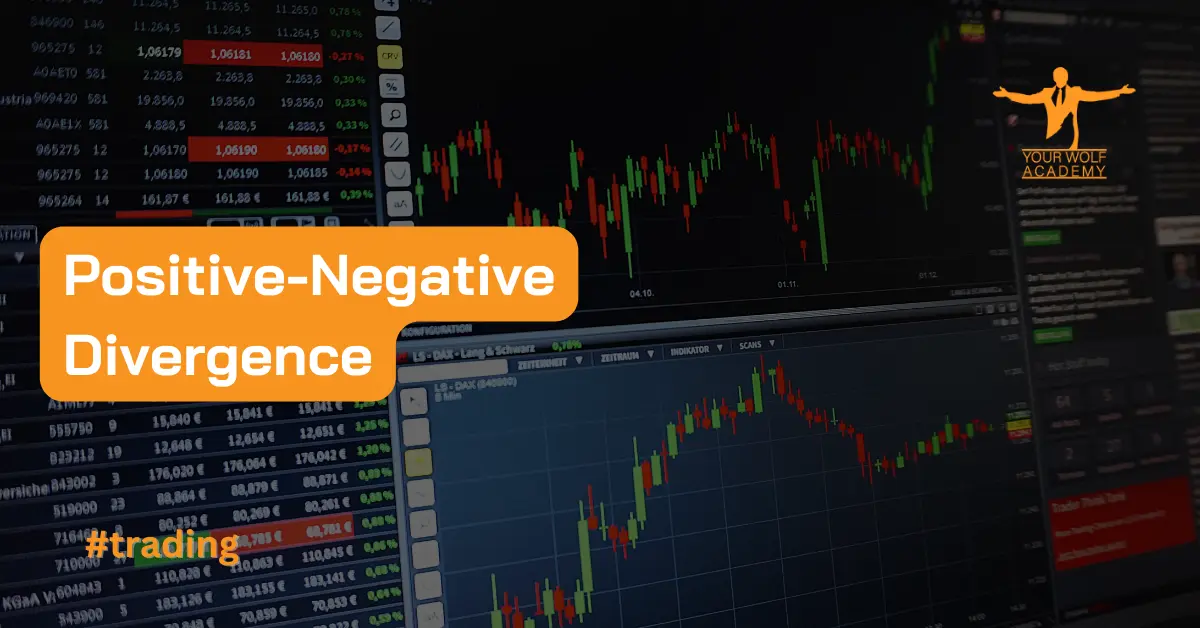In the world of technical analysis, traders and investors often rely on various tools and indicators to predict future price movements in financial markets. One such concept that holds significant importance is the notion of divergence.
Divergence refers to a situation where the price of an asset and a particular indicator move in different directions. This article will delve into the concept of positive-negative divergence, explaining what it means, how to identify it, and its implications for trading decisions.
Understanding Divergence
Divergence occurs when there is a discrepancy between the price action of an asset and a relevant technical indicator. It indicates a potential change in the trend and can be a valuable tool for traders to anticipate reversals or trend continuation. Positive and negative divergence are two variations of this concept, each providing distinct insights into the market dynamics.
Positive Divergence
Definition and Explanation
Positive divergence is characterized by a situation where the price of an asset forms lower lows, while the corresponding indicator registers higher lows. This disparity suggests that the prevailing downtrend may be losing momentum, signaling a potential reversal to an uptrend.
Example and Interpretation
Let’s consider a stock that has been experiencing a downtrend, with consecutive lower lows on the price chart. However, during the same period, the relative strength index (RSI) indicator displays higher lows. This positive divergence indicates that the selling pressure might be diminishing, and a bullish reversal could be imminent.
Benefits and Significance
Positive divergence provides traders with an opportunity to anticipate trend reversals and adjust their trading strategies accordingly. By identifying this pattern early, traders can potentially enter positions at favorable prices and capitalize on the upcoming uptrend.

Negative Divergence
Definition and Explanation
Negative divergence, on the other hand, occurs when the price of an asset forms higher highs, while the corresponding indicator registers lower highs. This discrepancy suggests that the prevailing uptrend may be losing strength, signaling a potential reversal to a downtrend.
Example and Interpretation
Let’s consider a cryptocurrency that has been in an uptrend, consistently forming higher highs on the price chart. However, the moving average convergence divergence (MACD) indicator displays lower highs during the same period. This negative divergence indicates that the buying momentum might be waning, and a bearish reversal could be on the horizon.
Implications and Risks
Negative divergence alerts traders to a potential trend reversal, providing an opportunity to adjust their trading strategies accordingly. By recognizing this pattern, traders can consider reducing or exiting their long positions to avoid potential losses in a declining market.
Identifying Divergence
To identify divergence accurately, traders rely on a combination of technical indicators and chart patterns.
Technical Indicators
These indicators provide valuable insights into the momentum, strength, and direction of price movements. By comparing the price action with the indicator readings, traders can identify divergences and make informed trading decisions.
Chart Patterns
In addition to indicators, traders also analyze chart patterns to identify divergence. Patterns such as double tops, double bottoms, head and shoulders, and triangles can reveal divergent signals when combined with price action and indicators. These patterns serve as visual cues to potential trend reversals or continuations.
Trading Strategies with Divergence
Understanding positive and negative divergence opens up opportunities for traders to develop effective trading strategies.
Positive Divergence Strategies
When positive divergence is detected, traders often look for confirmation signals such as bullish candlestick patterns or a surge in trading volume. They may consider initiating long positions or adjusting their existing trades to take advantage of the potential uptrend. Risk management techniques, such as placing stop-loss orders or trailing stops, can help protect against adverse price movements.
Negative Divergence Strategies
Similarly, when negative divergence is identified, traders may seek confirmation signals of a bearish reversal. These signals could include bearish candlestick patterns or increased selling volume. Traders might consider short-selling or reducing their long positions to capitalize on the anticipated downtrend. Employing risk management strategies remains crucial to mitigate potential losses.
Risk Management
Regardless of the trading strategy employed, risk management should always be a priority. Divergence-based trades come with inherent risks, as market conditions can change unexpectedly. Traders should determine their risk tolerance, set appropriate stop-loss levels, and avoid overexposure to a single trade or asset.
Real-Life Examples of Divergence
To better illustrate the concept of divergence, let’s examine a couple of real-life examples:
- Example 1: Stock XYZ is in a downtrend, forming lower lows on the price chart. However, the volume indicator displays higher lows. This positive divergence suggests a potential trend reversal and could prompt traders to consider long positions.
- Example 2: Currency pair ABC has been experiencing an uptrend, forming higher highs on the price chart. However, the relative strength index (RSI) indicator shows lower highs. This negative divergence implies a weakening uptrend and may lead traders to consider reducing their long positions.
Remember, thorough analysis and confirmation signals are crucial before making any trading decisions based on divergence.
Conclusion
Positive-negative divergence is a powerful concept in technical analysis that helps traders identify potential trend reversals or continuations. By understanding the dynamics between price action and indicators, traders can gain valuable insights into market sentiment and adjust their strategies accordingly.
However, it is important to remember that divergence is just one tool in a trader’s arsenal and should be used in conjunction with other analysis techniques for better accuracy.
Incorporating divergence analysis into your trading approach requires practice, patience, and continuous learning. By mastering this concept, you can enhance your trading skills and potentially improve your profitability in the dynamic world of financial markets.
FAQs
- What is the difference between positive and negative divergence? Positive divergence occurs when the price forms lower lows while the indicator registers higher lows, signaling a potential uptrend. Negative divergence, on the other hand, happens when the price forms higher highs while the indicator displays lower highs, suggesting a potential downtrend.
- What indicators can I use to detect divergence? Common indicators used to detect divergence include the relative strength index (RSI), moving average convergence divergence (MACD), stochastic oscillator, and the average directional index (ADX).
- How can I confirm divergence signals? Confirmation signals can include candlestick patterns, volume surges, or other indicators aligning with the divergence signal. These confirmatory factors provide additional evidence to support your trading decisions.
- Are there any risks involved in trading based on divergence? Yes, there are risks involved in trading based on divergence. Divergence is a powerful tool, but it is not foolproof. Market conditions can change unexpectedly, and false signals can occur. It is important to practice proper risk management techniques, such as setting stop-loss orders and diversifying your trades, to mitigate potential losses.
- Can divergence be applied to different financial markets? Yes, divergence analysis can be applied to various financial markets, including stocks, currencies, commodities, and cryptocurrencies. The concept of divergence remains the same across different markets, making it a versatile tool for traders.
- How can I learn more about divergence and its application in trading? To learn more about divergence and its application in trading, you can explore educational resources such as books, online courses, and trading forums. Additionally, practicing on demo accounts or paper trading can help you gain hands-on experience and refine your divergence analysis skills.
- Is divergence the only factor to consider when making trading decisions? No, divergence should be used in conjunction with other analysis techniques and factors. It is important to consider other aspects such as trend analysis, support and resistance levels, and market fundamentals to make well-informed trading decisions.
- Can beginner traders effectively use divergence in their trading strategies? Yes, beginner traders can effectively use divergence in their trading strategies with proper education and practice. However, it is advisable to start with small position sizes, focus on one or two indicators initially, and gradually expand your knowledge and skills as you gain experience.
- What are the potential benefits of incorporating divergence analysis into my trading approach? Incorporating divergence analysis into your trading approach can provide you with valuable insights into potential trend reversals or continuations. It can help you identify favorable entry and exit points, potentially improving your trading accuracy and profitability.
- Where can I find more resources on trading strategies and technical analysis? There are various online platforms, trading websites, and books that offer resources on trading strategies and technical analysis. It is important to conduct thorough research, read reviews, and choose reputable sources to enhance your knowledge and skills.


